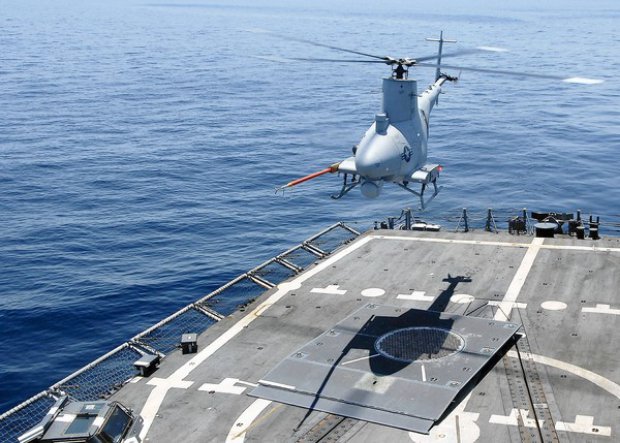 Fire Scout Over Frigate McInerney – Photo:MC2 Alan Gragg, US Navy
Fire Scout Over Frigate McInerney – Photo:MC2 Alan Gragg, US Navy
Reservists are at the controls of the MQ-8B Fire Scout unmanned helicopter for the aircraft’s deployment to Western Africa.
As part of an effort to determine manning for the unmanned aircraft, reserve officers will fly Fire Scout and enlisted reservists will maintain it on the planned six-month deployment on the frigate Simpson, which left Naval Station Mayport, Fla., on Jan. 17.
In another first, the two Fire Scouts are the only aircraft on the ship — there are no manned helicopters. This lets the squadron focus on the Fire Scout, said Captain Patrick Smith, Fire Scout programme manager, and frees up a Seahawk helicopter for other duties.
On its first two deployments, Fire Scout was flown by active-duty officers and maintained by active enlisted members. For its third, it will be flown by officers from Helicopter Anti-Submarine Squadron Light 60 Detachment 4, a reserve squadron that includes full-time support sailors, selected reservists and three active-duty members.
A “mixed bag” of reservists, active-duty sailors and contractors is being considered for when the drone is fully operational, Smith said.
Senior enlisted sailors have flown the Fire Scout on previous deployments, but they will not operate it on this one, Smith said.
HSL-60 started preparing for the Simpson deployment in early August. Squadron members, who have an H-60 Seahawk background, received training on operating and maintaining the drone. Most of the training occurred at Naval Air Station Jacksonville, Fla., and Naval Air Station Patuxent River, Md., but operators also spent a few days at Florida’s Cape Canaveral learning to fly Fire Scout over land — a first for this type of deployment, said Cmdr. William Howey, HSL-60’s commanding officer.
Senior officers are considering the role fleet replacement squadrons will play in cross-training pilots for Fire Scout. The goal is to have all helicopter pilots support Fire Scout detachments without creating any roadblocks for reaching rotary-wing career milestones, said Capt. Doug Tenhoopen, commander of Helicopter Maritime Strike Wing Atlantic.
Besides evaluating manning, the Simpson deployment is designed to test a litany of improvements, upgrades and procedures that were developed since Fire Scout deployed on frigate Halyburton. That cruise, which ended in August, included anti-piracy operations and action over Libya.
The first half of that deployment was plagued with technical glitches that hurt operations, including a finicky data-link that required officers to develop workarounds and often delayed or canceled sorties. Since then, communication between the aircraft and control stations has improved and the platform has become much more reliable, Navy officials said.
With the Simpson deployment, the programme office is testing new software, a more stable data-link, a laser range finder, integration with the ship and the aircraft’s overall reliability, Smith said.
Operationally, the office will test how Fire Scout responds to external cues; how it makes contact with unknown surface vessels; its intelligence, surveillance and reconnaissance capabilities in the littorals; and its ability to handle unplanned missions, Tenhoopen said.
The Halyburton deployment proved the unmanned aircraft’s value in supporting special operations; it’s also expected to help ease the “unquenchable thirst for ISR,” Tenhoopen said.
Simpson will participate in three exercises during its six-month deployment, including one in the Mediterranean and two near West Africa. In addition to European allies, it will work with forces from Senegal, Sierra Leone and Gambia, Tenhoopen said.
The programme office is evaluating the next step in the Fire Scout testing process, including what ships it will deploy on. Fire Scout was designed to complement the littoral combat ship, but the goal is to eventually put it on every aircraft-capable ship. The aircraft is expected to be on both LCS variants for tests early this summer, Smith said.
Additionally, the office is working to arm the aircraft with the Advance Precision Kill Weapon System, a capability requested by 5th Fleet and U.S. Central Command.
Source: Navy Times
